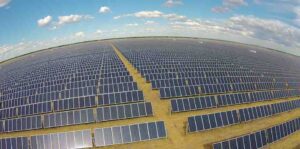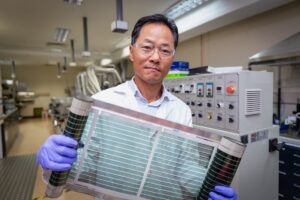A new study is adding more light to the arguments over whether farming and solar photovoltaics can coexist, with more data proving yet again that panels reduce the loss of valuable ground moisture.
Panels blocked 38 per cent of sunlight from reaching the ground, but thanks to plant adaptations to make the best of the shaded environment productivity fell by only 6-7 per cent, the study, published in Nature, found.
Water loss from the soil decreased by 1.3 per cent.
That’s a detail which could become a critical requirement for agriculture as the world notches hottest average global temperature records this week, and as some communities object to solar farms on the grounds that it sometimes takes away prime farming land.
“The minimal changes in carbon-water cycling occurred largely because plant photosynthetic traits underneath the panels changed to take advantage of the dynamic shading environment,” wrote the authors, led by Colorado State University’s Steven Kannenberg.
“Our results indicate that agrivoltaic systems can serve as a scalable way to expand solar energy production while maintaining ecosystem function in managed grasslands, especially in climates where water is more limiting than light.”
The next big thing
Agrivoltaics is the combination of agriculture and solar panels and it’s gaining traction around the world, and slowly even finding a place in Australia.
Last year, Spanish energy company Iberdrola won three tenders in France to design a solar array in such a way that it improves agricultural productivity, rather than the other way around.
Solar farms take up significant space and agrivoltaics could circumvent anger about solar farms locking up productive farmland, while bringing benefits such as reduced exposure to extreme weather, better ambient temperatures and shade for animals.
US studies have already proven better yields or more efficient water use for tomatoes, broccoli, chard, and jalapenos for ground-mounted solar.
Solar grazing is very popular in the US and Europe while the first such project in Australia began at the Royalla Solar Farm in 2015. By 2020 there were 13 known large-scale solar farms grazing sheep in the country, mainly in NSW but also in Victoria and Queensland.
But the preference in Australia by developers for 1P tracking solar panels, which are cheaper, closer together and lower to the ground, over 2P trackers limit the ability to use solar farm land for dual purposes.
However, the practice is gaining traction as more than two dozen agrivoltaic farms around Australia show.
The 128MW Numurkah Solar Farm in the north of Victoria hosts 2,000 sheep on 1,200 acres which provide lawn mowing services.
Lightsource BP is planning to build a 550MW array with a 260MW/520MWh big battery at the Goulburn River solar farm, using panels up to two metres above ground to make way for sheep.
And the Clean Energy Finance Corp and Octopus Australia recently invested in a 300MW solar farm with a 600MWh battery energy storage system in Bungendore, New South Wales, that plans to coexist with lamb production.
It’s not all happy sheep
There are problems with using agrivoltaics however, and concerns about the long term effect of a lack of sunlight on fodder and plant growth below.
Installing panels compacts soil and can reduce soil carbon and nutrients, but the Nature study indicated that with care, these can be prevented.
Furthermore, in a drought-prone country like Australia the extra protection from solar panels could be a rising solution to heatwaves.
“Concerns exist about the long-term impacts of agrivoltaic systems including the degree to which reductions in light availability will limit plant photosynthesis, and thus forage production,” the study said.
“There are cases, though, where reductions in light intensity may be beneficial due to associated decreases in water loss and photoinhibition. Water retention in grassland agrivoltaic systems could also translate into enhanced ecosystem resistance to weather extremes such as droughts or heat waves.”
Widespread adoption, the study says, will depend on designing a plant ecosystem under panels that can cope with the reduced or lack of sunlight over time.










